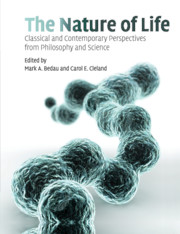Book contents
- Frontmatter
- Contents
- Preface
- Acknowledgments
- Sources
- About the authors
- Introduction
- SECTION I CLASSICAL DISCUSSIONS OF LIFE
- SECTION II THE ORIGIN AND EXTENT OF NATURAL LIFE
- SECTION III ARTIFICIAL LIFE AND SYNTHETIC BIOLOGY
- SECTION IV DEFINING AND EXPLAINING LIFE
- 23 Definitions of life
- 24 The seven pillars of life
- 25 A universal definition of life: autonomy and open-ended evolution
- 26 Does ‘life’ have a definition?
- 27 Sentient symphony
- 28 What is life?
- 29 Universal Darwinism
- 30 What is life? Was Schrödinger right?
- 31 Four puzzles about life
- Supplementary bibliography on life
- Index
- References
27 - Sentient symphony
Published online by Cambridge University Press: 10 November 2010
- Frontmatter
- Contents
- Preface
- Acknowledgments
- Sources
- About the authors
- Introduction
- SECTION I CLASSICAL DISCUSSIONS OF LIFE
- SECTION II THE ORIGIN AND EXTENT OF NATURAL LIFE
- SECTION III ARTIFICIAL LIFE AND SYNTHETIC BIOLOGY
- SECTION IV DEFINING AND EXPLAINING LIFE
- 23 Definitions of life
- 24 The seven pillars of life
- 25 A universal definition of life: autonomy and open-ended evolution
- 26 Does ‘life’ have a definition?
- 27 Sentient symphony
- 28 What is life?
- 29 Universal Darwinism
- 30 What is life? Was Schrödinger right?
- 31 Four puzzles about life
- Supplementary bibliography on life
- Index
- References
Summary
Owing to the imperfection of language, the offspring is termed a new animal; but is, in truth, a branch or elongation of the parent, since a part of the embryon animal is or was a part of the parent, and, therefore, in strict language, cannot be said to be entirely new at the time of its production, and, therefore, it may retain some of the habits of the parent system.
Erasmus DarwinThey say that habit is second nature. Who knows but nature is only first habit?
Blaise PascalThinking and being are one and the same.
ParmenidesA DOUBLE LIFE
What is life? Two crucial traits are that life produces (autopoietically self-maintains) and reproduces itself. Then there is inherited change: DNA and chromosome mutation, symbiosis, and sexual fusion of growing life when combined with natural selection means evolutionary change. Nonetheless, autopoiesis, reproduction, and evolution only begin to encompass the fullness of life.
We have glimpsed ways of describing what life is: a material process that sifts and surfs over matter like a strange, slow wave; a planetary exuberance; a solar phenomenon—the astronomically local transmutation of Earth's air, water, and received sunlight into cells. Life can be seen as an intricate pattern of growth and death, dispatch and retrenchment, transformation and decay. Connected through Darwinian time to the first bacteria and through Vernadskian space to all citizens of the biosphere, life is a single, expanding network. Life is matter gone wild, capable of choosing its own direction in order to forestall indefinitely the inevitable moment of thermodynamic equilibrium—death.
- Type
- Chapter
- Information
- The Nature of LifeClassical and Contemporary Perspectives from Philosophy and Science, pp. 340 - 354Publisher: Cambridge University PressPrint publication year: 2010
References
- 3
- Cited by



